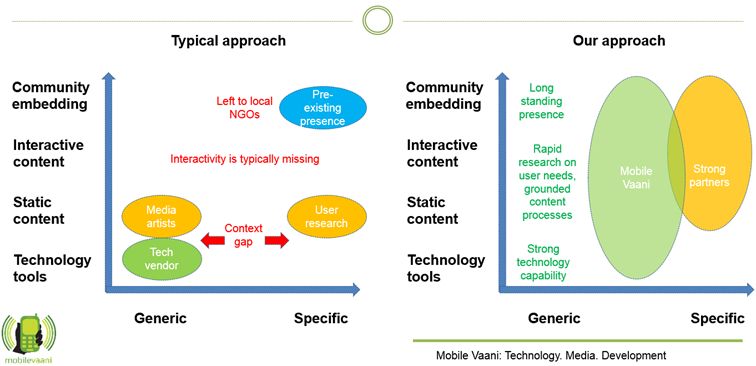ICTs for development have evolved through several stages. The very first stage in the mid-2000s was marked with hyped optimism that merely provisioning technology could work wonders by democratizing communication. However, the late 2000s forced a reality check with the realizations that many other aspects including user incentives and motivations, training, technology adoption, communitization of technology, stakeholder networking, and institutional responsiveness were fundamental ingredients for technology to realize its potential.
Gram Vaani was born in the midst of these realizations in 2009, and has evolved considerably over the years by embodying a comprehensive ICTs for development strategy, complete with community mobilization, content, and institutional linkages, in addition to the core backbone of using appropriate technology to drive change. Our new avatar, OnionDev, born through a strategic partnership with OnMobile’s Life Impacting Services business, captures this accurately through our name – that a multi-layered approach is needed for development, and that unpeeling the layers of the onion is not easy at all!
The infographic below chalks out our approach more clearly, and brings out the unique competency of OnionDev.

Most ICTs for development initiatives rely on sourcing a “technology vendor” to build the ICT component. However, this often results in a context gap because the technology vendor may not understand the development world or the project implementation constraints on the ground. Further, ICTs often tend to be designed with just the programmatic objective in mind, forgetting that the “users” are actually people who have varied interests and tastes, and need to draw excitement through interactivity and other engaging means to use new technology platforms that the development practitioners might be pushing towards them. Finally, very often projects are implemented by engaging local NGOs who understand the local conditions, but management feedback loops between the local NGOs and the administering NGO are not strong and the implementation is not tight enough.
Our strategy is the exact opposite. We are not a technology vendor, we are implementing our own Mobile Vaani program which has pre-built and tried-and-tested technology, content processes, field intervention, and institutional linkages. We understand what makes our users tick and what excitement is missing in their lives, which we can leverage to have them engage with our platforms. We understand our implementation geographies, and can further help guide our partners in using our technology in other geographies where we might not be present. Together with strong partners who bring in the appropriate domain expertise, we therefore feel that we can implement extremely strong development interventions, especially in the geographies where we are already working. The technology backbone on which our platforms and processes are built, additionally offers many opportunities for drawing causal inferences from observational data on how awareness and behavior change happens, barriers to change, and building up social accountability, community building, and collective action processes.



